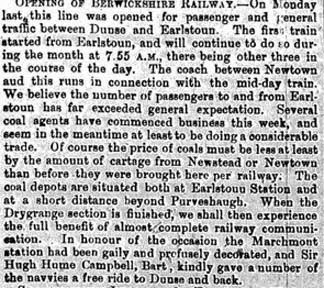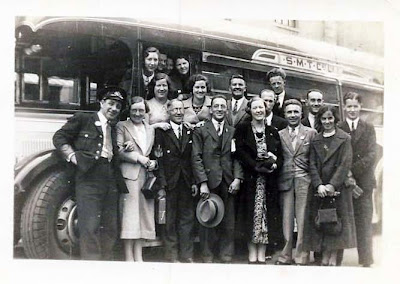The 1901 census for Earlston lists a William Donaldson, aged 37, a butcher at 43 High Street. with his wife Isabella and sons, John, William and Walter, and daughters Isabella and Helen. Two years later "Slater's Directory for Berwickshire, 1903" lists Walter Donaldson as the butcher.
You
can just make out the sign in the stone above the frontage, with the
staff in their striped aprons - and is that a carcase hanging in the
window?
A similar image. with the delivery boy and his bicycle.
Times have moved on to four wheels,
Staff outside the local Co-op Store
The~Co-op Travelling Shop that went around farms and more isolated communities.
In
the 1901 census, John P. Weatherly was described as a 40 years old
Postmaster of 73 High Street, living with his wife, mother-in-law and
children. Edward, Ellen and Margaret. The Trade Directory two years
later adds to his role that of bookseller, stationer, and printer.
John Paterson Weatherly (1924-2006) also ran the village
post office and earned a reputation as local historian, gathering a
wealth of archive material, which forms the basis of the collection of the Auld Earlston Group.
But take a closer look at that newspaper placard outside the shop, which announces that "Crippin Removed to Hospital".
Dr.
Hawley Harvey Crippen, was an American doctor He was hanged 23rd
November 1910 in Pentonville Prison, London for the murder of his wife
Cora Henrietta Crippen, and was the first criminal to be captured with
the aid of wireless telegraphy.
Here is Miller, Drapers, (where the Vets now have their surgery). Take a close look at the notice on the wall on the left, and
you can make out the advertisement for "Agent for Pullar's Dye Works, Perth", (presumably a
predecessor of Pullar's of Perth, Drycleaners). In 1881 34 year old John Miller of Thistle House, High Street was a draper in the village, employing two boys and one woman.
Occupying the same premises in 1901 was 25 year old draper George McDonald. Unmarried he was living at 15 Station Road with his father John, a saddler, mother Jane and two brothers David and James who were also saddlers. George must have been an enterprising lad, as at the age of 15 in the previous census of 1891, he was also listed as a draper.
********
Slater's Directory of Berwickshire for 1903 notes that the population of Earlston was 1677 (as per 1901 census). Shops in the village included:
6 grocers/spirit dealers/ironmongers, 3 butchers, 2 bakers, 5 tailor/drapers/ clothiers, 3 watchmakers/clockmakers/'jewellers, 1 confectioner, 1 chemist, 3 dressmakers/ milliners, and 1 fishman & earthenware dealer.
6 grocers/spirit dealers/ironmongers, 3 butchers, 2 bakers, 5 tailor/drapers/ clothiers, 3 watchmakers/clockmakers/'jewellers, 1 confectioner, 1 chemist, 3 dressmakers/ milliners, and 1 fishman & earthenware dealer.
What was striking was the number of women in business - Miss Jane Douglas,
confectioner; Mrs Margaret Kerr & Mrs Jane Readman grocers; Miss
Margaret Mcdonald, Miss Jane Wood & Miss Isa Tennant. dressmakers
& milliners; Mrs Agnes Smith, baby linen, Mrs Isabella
Winchester, draper, and "in charge of the telephone call office" Miss Isabella Aitchison.
Thirty years later in 1931 saw listed: 3 grocers/ironmonger, 1 butcher, 1 baker, 3 tailor/clothier/drapers, 1 watchmaker, 3 confectioner, 1 chemist, 3 milliners/dressmaker, and 2 newsagents.
Now we are left with 2 convenience stores, a butcher'
(Donaldson's), a baker, chemist, flower shop, sweet shop, 3 pubs/hotel, 2
hairdressers, a beauty salon, a craft shop, an electrical shop, a cafe
and a tearoom a fish & chip shop and a Chinese take-away - how
times have changed!
Earlston High Street
Thank you to everyone
who has donated or loaned old photographs for scanning.
who has donated or loaned old photographs for scanning.
Auld Earlston welcomes all contributions on the village's past -
contact us on auldearlston@aol.com or via the comments box below.
contact us on auldearlston@aol.com or via the comments box below.
**********
The
Crippen story aroused enormous public interest at the time - See more
at:
http://www.historytoday.com/richard-cavendish/execution-dr-crippen#sthash.Rvy7ZSbM.dpu





















































